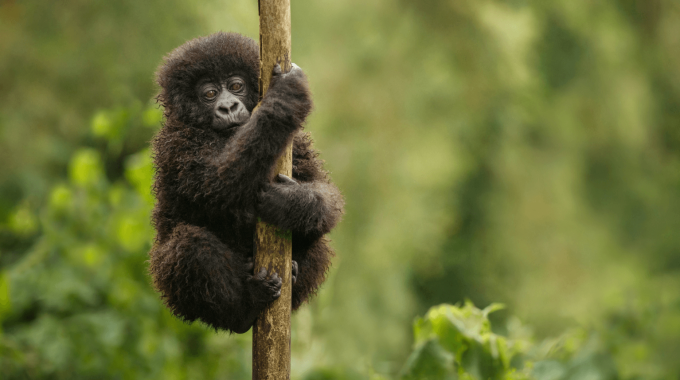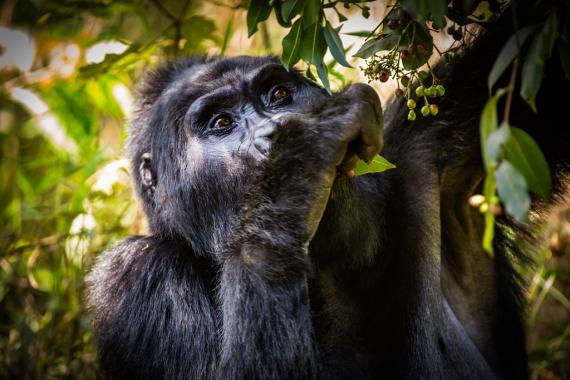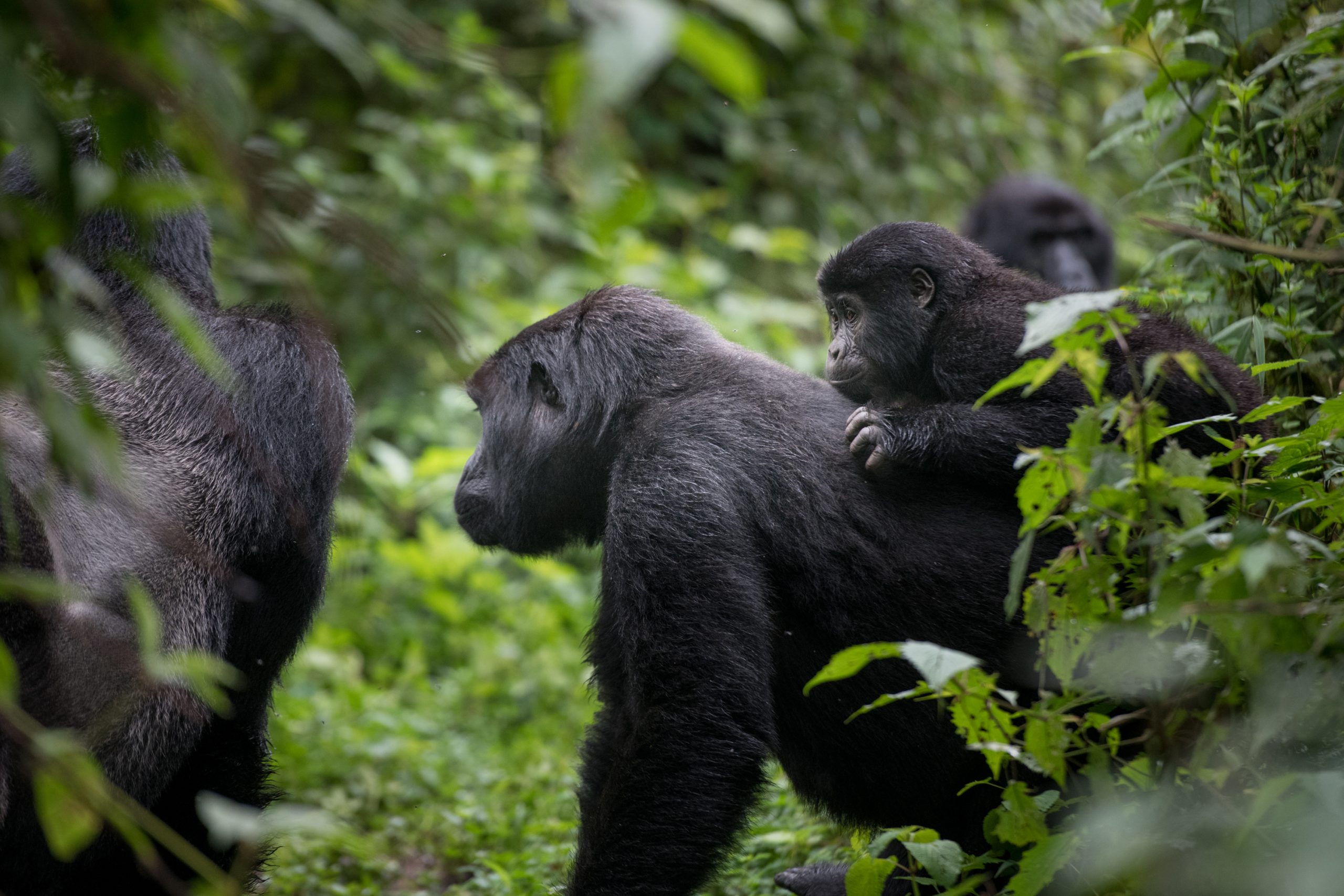
How Gorilla Trekking Benefits Conservation
How Gorilla Trekking Benefits Conservation
With a population of just over 1,000, mountain gorillas are endangered species. Yet, in this precarious situation, a unique form of tourism, gorilla trekking adventure has emerged, giving unprecedented hop for these great apes of Africa.
This unique form of eco-adventure enables tourists to observe the endangered mountain gorillas in their natural habitat, this experience has become a vital part of conservation efforts.
In this blog, we delve into how gorilla trekking supports conservation, drawing on extensive research and expert insights into the livelihood of these great apes.
Financial Support for Conservation
Gorilla trekking is a crucial source of funding for conservation efforts. For every tourist to take part in the gorilla treks must purchase a gorilla permit, and these permit fees generate substantial revenue directly channeled into various conservation activities in Uganda, Rwanda and the Congo. A gorilla permit in Rwanda costs $ 1,500 each, while in Uganda they cost $800 and in the DR.Congo costs $400. Over time, the value of these gorilla permits has grown because of the growing demand for this rare experience. Also, it is a strong commitment to sustainable practices to back it up. For example, in the first half of 2022, Volcanoes National Park in Rwanda generated $11 million from gorilla trekking permits alone. This revenue collected is allocated to various conservation efforts including
- Anti-poaching patrols: Gorilla permits help finance the recruitment, training and deployment of wildlife rangers who patrol gorilla habitats to put a stop to poaching and illegal activities. These patrols are essential for protecting gorillas from poachers who seek to hunt them for bushmeat, valuable body parts, or the illegal pet trade.

Gorilla - Habitat restoration: Revenue collected from gorilla trekking supports forest reforestation, teaches and encourages the locals in sustainable land use practices, and helps protect habitats from human encroachment, thus creating a healthy and safe environment for mountain gorillas to thrive.
- Gorilla monitoring and research: Gorilla permit fees help fund the work of primatologists who monitor gorilla families/groups to ensure their health and behavior are closely observed. This monitoring includes regular health checks, disease surveillance, and research into gorilla ecology. This research helps conservationists understand the needs of mountain gorillas, allowing them to modify gorilla conservation strategies as necessary.
- Community development project: A percentage of the revenue generated from gorilla trekking is often allocated to projects that benefit local communities living near gorilla habitats. This can include efforts in general community service like education, healthcare, water supply systems, and infrastructure development. Sharing of the gorilla trekking revenue fosters goodwill and encourages community participation in conservation initiatives.
With no doubt, a sustainable funding mechanism for these activities from gorilla trekking plays an important role in ensuring the future survival of mountain gorillas and their habitats. Also, it creates economic incentives for local communities to protect gorilla habitat and discourages harmful activities like poaching.
Raising Awareness and Promoting Conservation
In addition to financial support, gorilla trekking also helps raise awareness about the importance of primate conservation. Tourists who go on the daily gorilla treks get firsthand experience of how gorillas live in their natural environment, fostering a deeper understanding of the challenges they face. Also, they get to observe their natural behaviors, their social interactions, and the fragility of their ecosystem. This increased awareness can lead to greater public support for conservation efforts and policies that protect mountain gorillas and their habitats.
The plight of mountain gorillas was first brought to international attention in the 1960s by American Primatologist Dian Fossey, whose commitment to research and conservation played a crucial role in bringing attention to the dangers faced by gorillas. Thanks to her work, sustainable tourism initiatives such as gorilla trekking began to emerge. Unfortunately, before these conservation initiatives took off, gorillas were on the brink of extinction because of poaching.
Undoubtedly, gorilla trekking is one of the most exhilarating eco-adventures in Africa. It is also the most powerful experience that inspires travelers to advocate for conservation. Many visitors from all around the globe come back eager to share their experiences and the lessons they have learned, emphasizing the urgent need to protect these endangered animals. Through visitor stories, others are motivated to explore the important issues affecting gorillas and encouraged to contribute to their conservation. In the end, these gorilla treks help raise awareness about the challenges these magnificent creatures face, boosting support for conservation efforts around the world.
Regulations and Guidelines for Gorilla Trekking
There are several strict regulations and guides designed to ensure that gorilla trekking benefits conservation efforts as well as minimizing any negative impact from tourism. These regulations are consistent across all trekking destinations and they include
- Limited Gorilla Permits: Authorities in Uganda, Rwanda and DR.Congo issue a limited number of gorilla permits each day. This is done to control the number of visitors and minimize disturbance to the gorillas, it also ensures that the gorillas are not overwhelmed by the presence of humans and can continue their natural behaviors without undue stress.
- Minimum age for trekkers: The minimum age requirement for trekkers is 15 years. To minimize stress for gorillas, children under 15 should not interact with huge scary animals like gorillas. Young children may find such encounters overwhelming and could inadvertently transmit that stress to the mountain gorillas.
- Distance restrictions: All trekkers must maintain a safe distance of 10 meters (32 ft) from the gorillas to prevent stressing them and to avoid transmitting diseases. Also, this distance helps ensure the gorillas feel safe and secure in their environment.
- Time limits: To minimize disruption to the gorillas natural behavior, time spent with these gentle apes is usually limited to only one hour. This ensures that the gorillas’ daily routines are not significantly altered by the presence of tourists.
- Health checks: To ensure trekkers are not carrying any contagious illnesses that could harm the gorillas, they may undergo health screenings. This is a crucial step in preventing the spread of diseases that could decimate gorilla populations.
- Code of Conduct: All trekkers are briefed on appropriate behavior around mountain gorillas such as avoiding sudden movements, loud noises and direct eye contact. These guidelines are put in place to help prevent any actions that could frighten or provoke the gorillas.
These regulations are crucial for ensuring that gorilla safaris remain a sustainable and remarkable activity that benefits both the gorillas and the communities that coexist with them.
Community Involvement in Conservation
Also, gorilla trekking plays a vital role in engaging the local communities in conservation efforts. By providing economic opportunities and benefits to communities living near gorilla habitats, gorilla tourism creates incentives for them to protect the gorillas and their environment. Gorilla tourism also provides an incentive for local governments to protect primates.
This can involve the following
- Employment opportunities – Gorilla tourism creates jobs for local residents as guides, porters, trackers and in lodge services. This has provided a sustainable source of income for communities that may be previously relied on unsustainable practices like logging or poaching.
- Community – based tourism projects – Local communities can develop and manage tourism initiatives such as cultural tours, craft sales, and homestays, which provide them with a direct stake in conservation. This has empowered communities to take ownership of conservation efforts and benefit directly from tourism.
- Revenue-sharing schemes – A portion of the revenue generated from gorilla trekking can be allocated to community development projects, further incentivizing local participation in conservation. This can fund schools, healthcare facilities, and infrastructure improvements, improving the quality of life for local communities.
Gorilla trekking instills a sense of pride and accountability among local communities by actively involving them in these primate conservation initiatives. This approach creates a sustainable framework that benefits both wildlife and the people living nearby. Community tourisms offers a practical alternative for villagers who used to rely on practices that were harmful like gathering firewood or trapping animals in the forests. For example, the Karisoke Research Centre and the International Gorilla Conservation Programme (IGCP) have developed numerous conservation projects for other wildlife and communities living near the gorillas.

The Role of Research in Gorilla Conservation
Research in gorilla conservation is key to understanding what gorillas need and enhancing conservation efforts. Scientists dive into various studies to collect information about gorilla behavior, health, and social structures. The collected data helps shape conservation strategies, ensuring these magnificent primate stick around for the long haul. Exploring mountain gorilla tourism’s socio-economic benefits is a prime example of such research. This study examined how gorilla tourism positively impacts local communities and underscored the necessity of innovative management practices to promote sustainable tourism. It is a win-win for both gorillas and the communities living nearby.
Potential Negative Impacts and Mitigation Strategies
While gorilla trekking has many positive impacts on conservation, it is important to acknowledge the potential adverse effects and implement mitigation strategies.
Negative Impacts
Habitat disturbance: The presence of humans in gorilla habitats can disrupt the gorillas’ natural behavior and cause stress. This can affect their feeding patterns, social interactions, and overall well-being of these wild primates.
Disease transmission: Mountain gorillas are susceptible to many human diseases and close contact with tourists can increase the risk of transmission. This is a significant concern, as even common human illnesses can be fatal to gorillas. The spread of contagious diseases from humans to gorillas is a prominent anger exacerbated by gorilla trekking.
Environmental degradation: Infrastructure development for tourism, such as roads and lodges, can contribute to habitat fragmentation and pollution. This can have a negative impact on the gorillas’ environment and the wider ecosystem.
Mitigating Strategies
To address the negative impacts, researchers have implemented various strategies, including
- Strict regulations and guidelines : Regulations of visitor numbers, distance, and behavior help minimize disturbance and disease transmission. These regulations are essential for ensuring that gorilla trekking is conducted responsibly and sustainably.
- Health protocols : Trekkers are educated on health precautions during pre-trek briefings, such as wearing masks and refraining from trekking while sick, to reduce the risk of disease transmission. This helps to protect the gorillas from potentially harmful human diseases.
- Sustainable tourism practices : Eco-friendly lodges and responsible trekking practices help minimize the environmental footprint of gorilla tourism. This includes using sustainable building materials, minimizing waste and conserving enegy.
- Community engagement: Involving local communities in conservation efforts fosters a sense of responsibility and encourages them to protect the gorillas and their habitat. This initiative can include participating in anti-poaching patrols, monitoring gorilla groups, and educating others about the importance of conservation.
In conclusion: Gorilla Trekking has played a crucial role to help conserve these precious primates, this eco-adventure raises much – needed funds, spreads awareness and involves local communities, making a tangible impact on protecting endangered gorillas. While some risks are involved, strict guidelines, health measures and sustainable tourism practices help minimize them.
